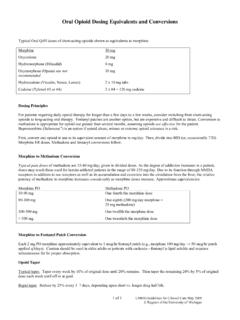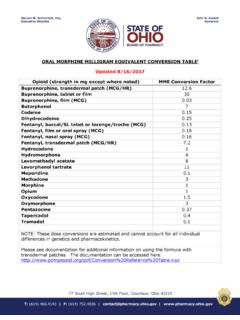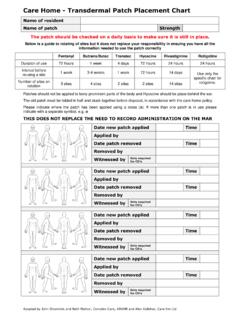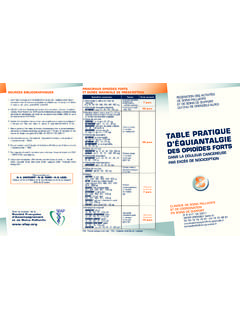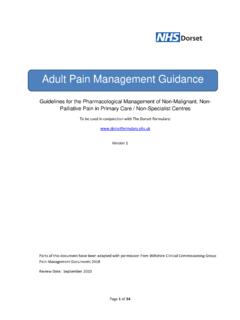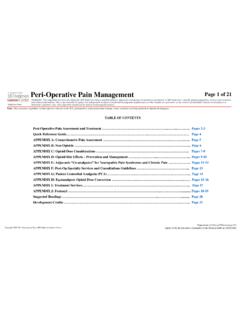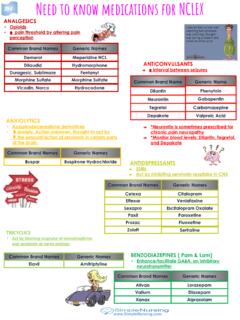Transcription of 2 chapter Prescriptions and Medication Orders
1 Prescriptions and Medication OrdersJane F. Bowen, PharmD, BCPSL earning OBJeCtiveSAfter successful completion of this chapter , the student should be able to:1. Identify the components of a prescription and Medication order2. Verify that a prescriber s DEA number is correct3. Interpret abbreviations and symbols that are commonly used in Prescriptions and Medication orders4. Interpret Prescriptions and Medication Orders to determine how they need to be prepared5. Identify the components of a Medication label6. Calculate a patient s percent adherence to a prescribed regimenKey terMSDEA numberInstitute for Safe Medication Practices (ISMP)Joint CommissionPrescription and Medication Orders intrODuCtiOn anD DeFinitiOnSPrescriptions and Medication Orders are the primary means by which prescribers communicate with pharmacists regarding the desired treatment regimen for a patient.
2 Prescriptions are used in the outpatient, or ambulatory, setting, whereas Medication Orders are used in the inpatient or institutional health system setting. Prescriptions and inpatient Orders are legal Orders that can be used for medications, devices, laboratory tests, proce-dures, and the like. The focus of this chapter is on Prescriptions and Orders for and Medication Orders can be handwritten, typed, preprinted, verbal, or entered into a computer program and submitted to the pharmacy by the patient or caregiver, or via fax, computer, or other electronic means. They can be for over-the-counter or legend (prescription) drugs. Unlike over-the-counter medications, which are determined by the Food and Drug Administration (FDA) to be safe and effective for use by the general public without a doctor s prescription, legend (prescription) drugs are to be used under the supervi-sion of a licensed practitioner.
3 Before dispensing the prescription or Medication order, the pharmacist s responsibility is to evaluate the prescription or Medication order for appropri-ateness. This includes ensuring the correct drug, dose and dosage form, frequency, route of 1723/08/14 1:56 AMadministration, duration of therapy, and indication. Additionally, the patient s profile is eval-uated for therapeutic duplication, drug allergies, drug disease state interactions, and drug drug interactions, and laboratory data are reviewed, if available. This process helps ensure that the benefits of the therapy are maximized and the potential for harm is minimized. BaSiCS OF Prescriptions anD Medication OrDerSAlthough different states may vary slightly in their requirements for what information needs to be contained on a prescription, in general, it must contain the following informa-tion: name of the patient, drug name, drug strength, drug dosage form, quantity prescribed, directions for use, and the name, address, and signature of the prescriber.
4 Additional infor-mation that may be included is the date of issue, number of refills authorized, address and/or date of birth of the patient, and prescriber s Drug Enforcement Administration (DEA) registration number. There are stricter regulations for Prescriptions written for scheduled or controlled substances. Additional information would be present on a prescription for a pediatric patient, such as patient age and weight, or a prescription from a veterinarian, which would include the animal species. A sample prescription is shown in Figure Orders typically contain similar information that would be included on a prescription. This includes the patient s name and a secondary identifier such as the patient s date of birth, medical record number, or social security number (less commonly used now); the patient s location and room number; date and time of the order; the drug name, dose, route, frequency, and duration; and the prescriber s name and signature, as shown in Figure Rusky309 South Street1/5/628/10/140B.
5 PajamoCiprofloxacin 500 mgSig: take 1 tab po bid x 7 daysDisp: 14 tabsB. Pajamo, Main , MD 12345 Figure Sample prescriptionPatient: John SmithAge: 68 Medical record number: 145693 Room: 3B-154 DateMedicationPrescriber8/108:23 am8/109:15 amVancomycin 1,500 mg IV q12hours x 3 daysD/c clindamycin 600 mg IV q6hoursKCl 20 mEq in 1 L IV at100 ml/hr x 1 literAcetaminophen 650mg POq6 hours prn temp >101 FB. Pajamo,MDB. Pajamo,MDB. Pajamo,MDB. Pajamo,MDFigure Sample Medication order18 chapter 2 / Prescriptions and Medication Orders 1823/08/14 1:56 AMProviders who prescribe controlled substances must register with the DEA to do so. They are provided with a DEA registration number that must be indicated on Prescriptions and Orders for controlled substances. The DEA number is a unique number that contains two letters and seven numbers.
6 This number can be verified to help identify fraudulent registration numbers and Prescriptions . Let s use DEA number AF1234563 as an example. For prescribers, the first character in their DEA number should be the letter A or B. For mid-level practitioners ( , physician s assistant [PA], nurse practitioner [NP], etc.), the first character is the letter M. The second character of the DEA number is the first letter of the prescriber s last name, unless, for example, the prescriber recently got married and changed their last name after receiving a DEA number. Our prescriber s last name should start with the letter F. The seven digits that follow the letters can be verified mathemati-cally as well. First, add the odd numbers, the first, third, and fifth digits (1 1 3 1 5 5 9). Second, add the even numbers, the second, fourth, and sixth digits, and multiply the sum by 2 (2 1 4 1 6 5 12; 12 3 2 5 24).
7 Finally, add the results from the first two steps (9 1 24 5 33). The far right digit of this number (3) should be the same as the seventh digit of the DEA number (3).test yourself the following DEA registration numbers:1. NameAddressRefillsJane Rusky309 South StreetDateDOB1/5/628/10 no. AP2426814B. PajamoOxycodone 5 mgSig: take 1 2 tabs po q4 6h prn painDisp: 30 tabsB. Pajamo, Main , MD 123452. no. BP9637134 DOBJohn Smith51 Broadway PajamoFentanyl patch 25 mcg/hrSig: apply 1 patch q3 daysDisp: 10 patchesB. Pajamo, Main , MD / Basics of Prescriptions and Medication Orders 1923/08/14 1:56 AM3. no. MR6839407 DOBJ ulie Woods217 Central RobertsPercocet 5/325 mgSig: take 1 tab po q6h prn painDisp: 40 tabsC. Roberts, Main , MD 12345 aBBreviatiOnS anD SyMBOLS COMMOnLy uSeD in Prescriptions anD Medication OrDerSAbbreviations and symbols are common in Prescriptions and Medication Orders .
8 Although they may save time for the prescriber, they are sometimes a source of confusion and can be misinterpreted, resulting in Medication errors. As a result, the Joint Commission (for-merly the Joint Commission on Accreditation of Healthcare Organizations, or JCAHCO) requires healthcare organizations to develop an approach to standardizing abbreviations, acronyms, and symbols, as well as to create a list of those that should not be used. Com-monly used abbreviations and symbols are listed in Table The ones marked with an asterisk (*) have been identified by the Joint Commission and the Institute for Safe Medication Practices (ISMP) to be frequently misinterpreted and involved in harmful Medication errors. ISMP has published a comprehensive list of symbols, abbrevia-tions, and dose designations that lead to harmful Medication errors called ISMP s List of Error-Prone Abbreviations, Symbols, and Dose Designations.
9 The use of these should be avoided; however, they are still being used so their definitions need to be understood. Periods may or may not be present in between areaBWBody mealsCCentigradeABWA ctual body weightc or c WithadUp *Right earcc*Cubic , crmCreamampAmpuledDayAPAP*Acetaminophend isc, *, d/c* *Left eardivDivideASAA spirinDOBDate of birthAT CAround the clockDSDouble *Each as such a dayDWDistilled a weekD5 NSDextrose 5% in normal salineBMIBody mass indexD5 NSDextrose 5% in normal saline ( NaCl)BSABody surface areaD5 WDextrose 5% in watertaBLe Commonly used abbreviations in prescription writing, along with their definitions20 chapter 2 / Prescriptions and Medication Orders 2023/08/14 1:56 AMAbbreviationDefinitionAbbreviationDefi nitionECEnteric coatedOTCOver the *Each directedozOunceFFahrenheitp or perByfl or or or mouthgtt, gttsDrop, dropspostAfterh, hr, or HourPPMP arts per millionHCTZ* *At bedtimepre-opBefore surgeryIBWI deal body *Every dayIU*International times a dayIUDI ntrauterine *Every other quantityIVPI ntravenous adA sufficient quantity to makeIVPBI ntravenous piggy backs or s Withoutjt or j-tubeJejunostomy tubesc*, sq*, subq*, or subcut SubcutaneousKVOKeep vein on labelLLiterSLSublingualLELower Ringer s injectionss*One halfM2 or m2 Square or g* dose doseml or of times a daymOsm or mOsmolMilliosmoletincTinctureMRMay *Three times a weekMRX_May repeat _ timestopTopicallyNG or NGTN asogastric or nasogastric or * or u*Unit(s)
10 * or utdictAs directednon rep. or not repeat or no refillsUEUpper extremitiesNPON othing by saline ( NaCl) NSHalf-strength normal saline ( NaCl) *Right *Left eyexTimesData from: Thompson JE. A Practical Guide to Contemporary Pharmacy Practice. 3rd ed. Philadelphia, PA: Lippincott Williams (continued) / Abbreviations and Symbols Commonly Used in Prescriptions and Medication Orders 2123/08/14 1:56 AMIn addition to commonly used abbreviations that should be avoided because of the potential for misinterpretation, ISMP suggests the following when writing numbers for doses on a prescription: Do not use trailing zeros for doses expressed as whole numbers. If the dose on a pre-scription is 1 milligram, it should be written as 1 mg and not mg.










